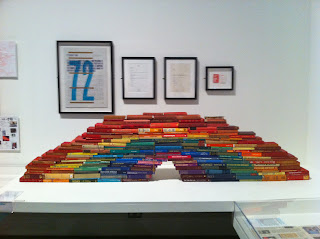Our trip to London was not entirely focused on tapestry. One of the most exciting parts of the trip was my first trip to the
Design Museum.
 |
| Design Museum, London |
 |
| Brit Insurance Design Awards Exhibition 2010, Design Museum, London |
The
Brit Insurance Design Awards Exhibition was full of fascinating items and inventions, from fashion collections to folding bicycles, community libraries to solar-powered ovens. Some of my favourite items included
PARCS furniture (coloured items of modular furniture to challenge the way we imagine the workplace), the
Young Creative Network's Library (for its interactive and design-led approach to library services) and
Soma by Ayala Serfaty (a haunting installation of floor-based lights made from tinted glass filaments).
 |
| PARCS Furniture |
 |
| Young Creative Network Library |
 |
| Soma by Ayala Serfaty |
Our visit to London was rounded off with a visit to Tate Modern. I was surpised at the number of artworks in the main galleries which were made from textiles or tapestry. One room was entirely devoted to Magdalena Abakanowicz's
Abakan Red and
Abakan Orange tapestry installations. In another, an untitled
Robert Morris work of the 1960s was hung opposite
Jannis Kounellis' work of the same period, featuring shanks of un-spun wool hanging over a wooden rack.
The highlight for me, by far, was
Ai Weiwei's installation for The Unilever Series,
Sunflower Seeds. The floor of one end of the turbine hall was covered in hundreds of thousands of ceramic sunflower seeds, created to scale. These created a beautiful grey carpet, intended for people to walk. Heartbreakingly, due to health and safety concerns the installation had been roped off, stopping anyone from walking on it. Despite this set-back, the installation still held its own and created an atmosphere of peace and intrigue.
Given my positive response to this work, I was shocked to read an article in the Guardian on the train home by artist Heather Chalmers (
'These cuts are no blitzkrieg on the arts - funding has been wasted'). Without getting into the politics of her article (since Friday, it has received 110 online comments), I could not understand her use of the sunflower seeds as an example of how Tate Modern wastes it spaces by showing "some piece of tat" in its turbine hall. She criticises the use of high-profile works to draw in younger audiences but when I visited Tate Modern on Friday this installation was achieving just that. The turbine hall was full of secondary school pupils, avidly watching the documentary on how the ceramic seeds were made. How many other opportunities are there in free galleries for school-age children to learn about the skill and patience which goes into objects such as these? In the V&A, there was no film illustrating how the Raphael tapestries were made.
Opinions over the use of arts funding are never going to be objective. For me,
Sunflower Seeds is perhaps my pick of the year so far for the emotional responses it provokes and Tate's informative ways of teaching us about the creative process.





